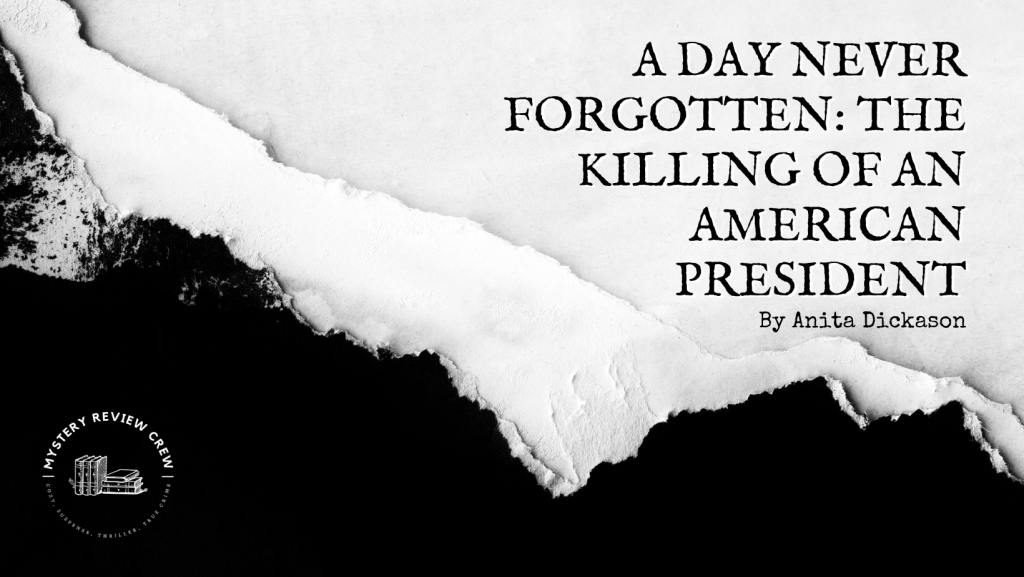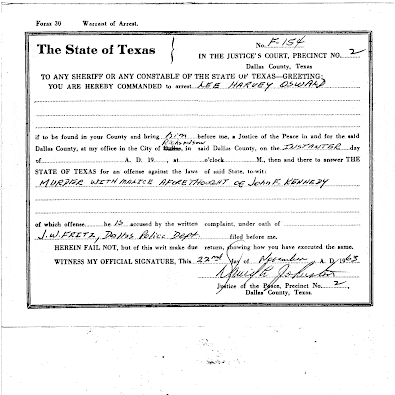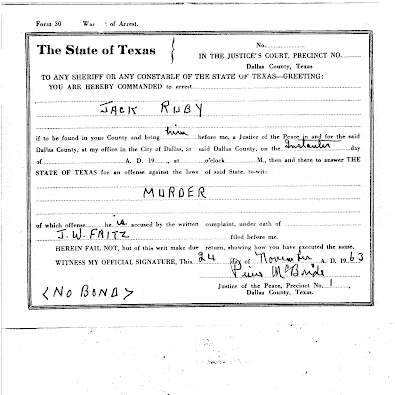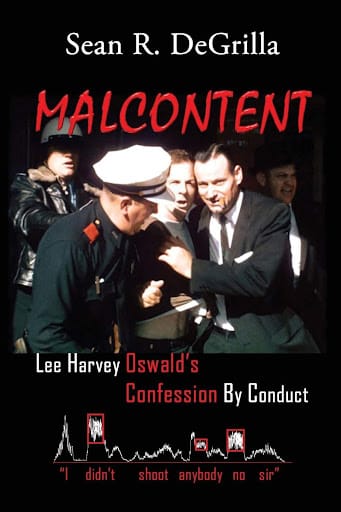This month for True Crime November we’re talking about the Assassination of President John F. Kennedy, the 35th President of the United States.
November 22, 1963—the day the killing of a President shocked a nation. A horrific event that is forever woven into the pattern of lives, memories, and annals of American history.
In 1963, television was a primary source of news. People were glued to their sets as they watched the events unfold in Dallas. In my hometown in Colorado, I watched Walter Cronkite announce the death of President John F. Kennedy. I watched as Lee Harvey Oswald, handcuffed to Dallas Homicide Detective Jim Leavelle, was escorted through a door leading to the underground parking garage of the Dallas Police Department. I watched as Jack Ruby stepped forward and fired a gun, killing Oswald. Images I have never forgotten. Years later, as a Dallas police officer, the first time I drove down the ramp into the same parking garage, I had a chilling sense of déjà vu.

*Affiliate links are used in this article. The Mystery Review Crew is an Amazon Affiliate and, as such, earns from qualifying purchases. See our privacy policy and disclosures for more information.
It wasn’t until 2013 that I became actively involved in the conspiracy surrounding Kennedy’s death. Oddly enough, it was due to the death of a witness to the assassination. Lee Bowers Jr. worked for the railroad and, on the day of the assassination, was in the railroad tower overlooking Dealey Plaza. In 1966, Bowers died when his car hit a bridge outside of Midlothian, Texas, a small town south of Dallas. Over the years, conspiracy theorists claimed Bowers’ death wasn’t an accident. He was killed because of what he saw the day Kennedy was shot.

A series of events, starting with a phone call from a California film producer, culminated in my reconstruction of Bowers’ accident. I published a book, JFK Assassination Eyewitness: Rush to Conspiracy, detailing the results of my investigation. During my research, I discovered several inconsistencies within documents that dealt with Bowers’ death. One of which was the role of the Justice of the Peace in the legal proceedings in the aftermath of Bowers’ accident.
Since Bowers’ death was intertwined with the Kennedy assassination, I came across numerous archived documents detailing the role the Justices of the Peace played in the events following President Kennedy’s death. Dallas County Justice of the Peace David L. Johnston signed the arrest warrant for Lee Harvey Oswald. Dallas County Justice of the Peace Pierce McBride signed the arrest warrant for Jack Ruby.
Result of a Conspiracy or Fact?


Justice of the Peace David L. Johnston was ultimately called to testify before the Warren Commission. Here are excerpts of his testimony.
“Mr. HUBERT. What are the general duties of the justice of the peace in Texas?
Mr. JOHNSTON. The justice of the peace in Texas has civil jurisdiction up to $200 in civil matters; has misdemeanor jurisdiction as provided by the statutes for criminal offenses of a misdemeanor nature in which the fine does not exceed $200 plus the costs. He is the acting coroner under our statutes. He is a magistrate. He can hold courts of inquiry, issue search warrants or any process relevant to a felonious act in the State of Texas.
Mr. HUBERT. Were you the justice of peace that arraigned Oswald?
Mr. JOHNSTON. Yes; I arraigned Lee Harvey Oswald–let me give you the sequence of them–that’s the easiest thing to do. I brought the complete record and I have everything here. The first charge that was filed was for murder with malice of Officer J. D. Tippit of the Dallas Police Department in cause No. F-153, The State of Texas versus Lee Harvey Oswald. This complaint was filed at 7:05 p.m. on the 22d day of November 1963.
Mr. HUBERT. By whom?
Mr. JOHNSTON. By Capt. J. W. Fritz, captain of the homicide bureau, Dallas Police Department, was accepted by W. F. Alexander who is William F. Alexander, an assistant criminal district attorney of Dallas County, Tex., which was passed over to me at 7:05 p.m. The actual complaint was signed at 7:04 p.m. and I arraigned Lee Harvey Oswald at 7:10 p.m. on November 22, 1963, advising him of his constitutional rights and that he had to make no statement at all, and that any statement he made may be used in evidence against him for the offense concerning which this affidavit was taken, and remanded the defendant to the custody of the sheriff of Dallas County, Tex., with no bond as capital offense.”
Mr. HUBERT. Had you been called specially for this arraignment or did you happen to be there?
Mr. JOHNSTON. I was first called to handle the issuance of the search warrant involving the residence at 1026 North Beckley.
Mr. HUBERT. Did you issue that search warrant?
Mr. JOHNSTON. Yes; and not only did I issue the search warrant, I was requested by the officers to go with them and also Assistant District Attorney Bill Alexander was in on that search also, which turned out to be the room in which Lee Harvey Oswald had been living on North Beckley. I was present when that search was made and also seizure of the things that were in his room.
Mr. HUBERT. Now, let’s pass to the arraignment concerning President Kennedy, and I wish you would dictate into the record the same information you did as to the first one.
Mr. JOHNSTON. All right, sir. This was the arraignment of Lee Harvey Oswald for the murder with malice of John F. Kennedy, cause No. F-154, The State of Texas versus Lee Harvey Oswald. The complaint was filed at 11:25 p.m., was accepted by me at 11:26 p.m. It was filed at approximately 11:25 p.m. by Capt. J. W. Fritz, homicide bureau of the Dallas Police Department, and was accepted by Henry Wade, criminal district attorney, Dallas County, Tex., and was docketed as cause No. 154, F-154 at 11:26 p.m.
Mr. HUBERT. What happened at this arraignment–was it the same as before?
Mr. JOHNSTON. That arraignment was held at 1:35 a.m., November 23, 1963, in the identification bureau of the Dallas Police Department, and once again I appraised him of his constitutional rights, read the affidavit, and advised him again that I remanded him to the custody of the sheriff, Dallas County, denying bond as capital offense.”
The arraignments by Justice of the Peace David L. Johnston were the reason Lee Harvey Oswald was handcuffed to a Dallas detective in the parking garage of the Dallas Police Department on November 24, 1963. In compliance with two orders to remand Lee Harvey Oswald to the custody of the Dallas County sheriff, Oswald was being transferred from the city jail inside the Dallas Police Department to the Dallas County jail.
Texas Justice of the Peace
A Texas Justice of the Peace is elected, and there is no requirement to have a law degree. In the Texas Judicial System, the only court lower on the totem pole than a Justice of the Peace is a municipal court. To understand how Justices of the Peace, near the bottom of the ladder of Texas judges, became instrumental in the investigation of the death of the most powerful elected official in the United States Government, one needs to step back in time.

As a true crime enthusiast, I found the role of the Justice of the Peace to be an intriguing study in Texas history. The position dates back to the frontier days when the individual was appointed, not elected. The first appointment of a Justice of the Peace occurred in 1823 in the Colorado District of Stephen F. Austin’s first colony in Texas. Judge Roy Bean was one of the most famous. Appointed in 1882, Judge Bean held court in his saloon, the Jersey Lillie, in Langtry, Texas. Bean called himself the “Law West of the Pecos.”
In 1836, Texas declared its independence from Mexico. The Texas Republic Constitution of 1836 stipulated each county would elect a specified number of Justices of the Peace for a two-year term. It wasn’t until 1954 that the term of office was extended to four years.
Texas Code of Criminal Procedure governs the rules and responsibilities of the Justice of the Peace. Before the advent of a medical examiner system, a Justice of the Peace was the county coroner for the investigation of unattended deaths, homicides, suicides, and accidental deaths. The JP was responsible for holding an inquest (with or without a jury), obtaining evidence and witness statements, ordering an autopsy, pronouncing death, signing the death certificate, issuing warrants of arrest, subpoenas, and other required legal documents. The Texas Code of Criminal Procedure required the Justice of the Peace in the county where the death occurred to be notified. This is still the case in many Texas counties that do not have a medical examiner.
Texas Medical Examiner System
Historically, the inherent problems within the Justice of the Peace system dealing with deaths that required an investigation led a group of physicians and attorneys to lobby for legislative action, allowing heavily populated counties to establish positions for medical examiners specifically trained in conducting autopsies. In 1955, the Texas Legislature amended the Code of Criminal Procedure to allow a medical examiner system for any county with a population of more than 250,000.
Once a county enacted the new law and established a medical examiner system, the duties and responsibilities assigned to the Justice of the Peace transferred to the county medical examiner. The new law stipulated a criminal penalty for violations of the Medical Examiner Section, Chapter 49 of the Code of Criminal Procedure, punishable by a fine, imprisonment in the county jail or both. The only sanction under the Justice of the Peace system was a fine for hindering inquest proceedings. At the time, only four counties qualified, and Dallas was one.
Dallas County Medical System
The state allowed for one exception. If a county had a medical school, then the school would qualify for the purpose of conducting autopsies instead of adopting the medical examiner system. Dallas County initially elected not to establish a medical examiner system because the county had a medical school.
1963
A few months before President Kennedy was assassinated, Dr. Earl Rose was hired as the medical examiner for Dallas County. One of his responsibilities was establishing a county medical examiner system, which didn’t happen until 1969 when Dallas County adopted the new law. When President John F. Kennedy was shot in downtown Dallas, his motorcade immediately headed to Parkland Hospital, the trauma center for Dallas County. Once President Kennedy died, per Texas law, a Justice of the Peace was in charge of the proceedings. Per Texas law, Kennedy’s death required notification to the Justice of the Peace for the county precinct where the death occurred. Per Texas law, the Justice of the Peace was required to hold an inquest, order an autopsy, conduct an investigation, and sign the death certificate detailing the inquest findings.
Dallas County Justice of the Peace Theran Ward was one of the county officials waiting for the President to arrive at the Dallas Trade Mart for Kennedy’s speaking engagement. In a subsequent interview, Ward stated he had no idea why he had been ordered to go to Parkland Hospital. As such, Justice of the Peace Theran Ward became the legal voice at Parkland Hospital, charged with carrying out the responsibilities as outlined in the Texas Code of Criminal Procedure.
Some reports state Dr. Rose and Justice of the Peace Theran Ward did attempt to stop the Secret Service agents from illegally removing the President’s body from the hospital. The agents overrode their protests, and President Kennedy’s body was flown to Bethesda Naval Hospital in Bethesda, Maryland, where an autopsy was performed. Dr. George Burkley, the Physician to the President, signed a death certificate. Burkley was present in the motorcade in Dallas and at Parkland.
Justice of the Peace Theran Ward did issue a Texas death certificate and held an inquest. These documents were signed on December 6, 1963. However, the official death certificate only states, “Held Inquest.” There is no corresponding date and time when this event occurred. The references to the gunshot wounds, particularly the comments in the Inquest Hearing document, echoed the findings of the autopsy held in Maryland. By contrast is the death certificate for Lee Harvey Oswald, detailing the results of Justice of the Peace Pierce McBride’s inquest hearing and autopsy results.
Dallas County Justice of the Peace Theran Ward signed the death certificate for President John F. Kennedy. Dallas County Justice of the Peace Pierce McBride signed the death certificate for Lee Harvey Oswald. In 1967, Jack Ruby died. Dallas County Justice of the Peace W.E. Richburg signed the death certificate. Richburg was the same Dallas County Justice of the Peace who signed the death certificate for Lee Bowers, Jr. after Bowers was killed when his car hit a bridge south of Midlothian, Texas, on August 9, 1966. The crash site was in Ellis County, not Dallas County.
Death certificate for President John F. Kennedy signed by Justice of the Peace Theran Ward.

Kennedy inquest hearing by Justice of the Peace Theran Ward.

Death certificate for President John Fitzgerald Kennedy signed by Dr. George Burkley, Page 1.

Death certificate for President John F. Kennedy signed by Dr. George Burkley, Page 2

Death certificate of Lee Harvey Oswald signed by Justice of the Peace Pierce McBride

Death certificate for Jack Ruby signed by Justice of the Peace W.E. Richburg.

Inquest hearing for Jack Ruby signed by Justice of the Peace W.E. Richburg.

Time has not dulled the fervor to know the truth of what happened on that fateful day when an American President was gunned down. New information, books, and documents fuel the controversy.
A new documentary, JFK’s E.R. doctors share new assassination details, adds weight to the theory of a second shooter. The wound in the throat was not an exit wound, as assumed during the autopsy of President Kennedy, but an entrance wound. Parkland Hospital was and still is the trauma center for Dallas. Emergency room doctors were very familiar with traumatic injuries, including gunshot victims.
For sixty years, the debate has raged.
Was Lee Harvey Oswald the killer?
Did Oswald act alone?
Or was there another assassin on the grassy knoll that day?
JFK Autopsy Report:
https://en.wikipedia.org/wiki/John_F._Kennedy_autopsy
Books We Found Helpful in Understanding the Facts of the JFK Assassination

MALCONTENT: Lee Harvey Oswald’s Confession by Conduct By Sean DeGrilla
“To understand the Kennedy assassination, it is imperative to first understand Lee Harvey Oswald. The man—who on November 22, 1963—brought a nation to its knees. This book takes the investigation of Oswald’s actions and words surrounding the deaths of a President and a police officer in a radically new direction. A law enforcement analysis as seen through the spectrum of Consciousness of Guilt is coupled with the first-ever Computer Voice Stress Analysis of Lee Harvey Oswald.
The personal assassination notes of the Dallas Homicide Detective at the heart of the investigation and handcuffed to Oswald during that fateful shooting are published here for the first time.
Published for the first time, the writings of Michael Paine explores his unique knowledge and political conversations with Oswald. This book sheds new light on a controversy that has raged for over 50 years.
Was Lee Harvey Oswald guilty or a self-proclaimed patsy?”

THE FINAL WITNESS By Paul Landis
“Dallas, Texas. November 22, 1963. Shots ring out at Dealey Plaza. The president is struck in the head by a rifle bullet. Confusion reigns.
Special Agent Paul Landis is in the follow-up car directly behind JFK’s and is at the president’s limo as soon as it stops at Parkland Memorial Hospital. He is inside Trauma Room #1, where the president is pronounced dead. He is on Air Force One with the president’s casket on the flight back to Washington, DC; an eyewitness to Lyndon Johnson taking the oath of office.
What he saw is indelibly imprinted upon his psyche. He writes and files his report. And yet . . . Agent Landis is never called to testify to the Warren Commission. The one person who could have supplied key answers is never asked questions.
By mid-1964, the nightmares from Dallas remain, and he resigns. It isn’t until the fiftieth anniversary that he begins to talk about it, and he reads his first books on the assassination.
Landis learns about the raging conspiracy theories—and realizes where they all go wrong.”






I’ll always want to know more. Living in Arlington, just 23 miles away, the citizens of the DFW area were deeply impacted. I remember the TV being on past midnight. Daddy pulling over to the curb as we were heading home from church to purchase the special edition of the Fort Worth Star-Telegram regarding the shooting of Lee Harvey Oswald that Sunday morning. Of special remembrance of all that happened that fateful day in Dallas which was the day of Arlington High School Homecoming activities. It is a day that many will never forget. Sitting in the car listening to the radio during lunch, hearing the announcement of Kennedy’s death, and not knowing what to do. Our classes were canceled following the announcement of Kennedy’s death as well as all Homecoming activities, school closed. It is a day that many will never forget.
It’s a day that still resonates in my memories. I have to wonder if we will ever know the truth behind what happened that day.
The day President Kennedy was Shot, I was in gym class excited for it to over with. I was scheduled to be picked up early for a special dinner with a friend of my dad’s. Next to me was a young girl, (I call Sarah) was also excited to see a family friend. The time dragged on, I knew something was wrong when gym had been over thirty minutes and we were still there. Then three men walked in and nodded at the teacher. She explained that President Kennedy was dead. The minute she said that, Sarah, began screaming. The men rushed to her side and she was given an injection to help calm her down.
I learned then our families were dispose to have dinner with the Kennedys. Both our fathers knew the Kennedy family. Sixty years later I still remember every detail.
It truly is a day that will never be forgotten.